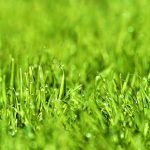Tips On How To Properly Care For Your Fescue Lawn
This suggested maintenance practices calendar is designed to serve as a general guide of how to care for your Marietta, Georgia Fescue lawn.
Fescue Lawn Care Depends On Many Factors
Health of your Fescue lawn, soil type, and location, amongst other factors tend to affect how your Fescue turf will perform. It is because of these reasons that the following turf management dates and practices need to be adjusted to ensure that your specific lawns conditions improve.
Mowing Fescue Grass From March To May
Mowing: Mow your lawn to height of approx. 3-4 inches. It is important that you mow your lawn as frequently as possible to ensure that no more than a third of your grass blades is removed.
It is also crucial that you always leave the clippings on the lawn – this practice is known as “grass-cycling”. These clippings decompose quite fast and don’t contribute to thatch.
Fescue Turf Fertilizing
It is important that you don’t apply fertilizer on tall Fescue past March 15 because of Georgia’s extreme summer heat.
Irrigating Your Marietta Fescue Grass
It is important that you water as required to avoid drought. For every application about an inch of water every week is acceptable. Sandy soils will generally require frequent watering, or about half an inch of water after every three days.
Fescue Lawn Weed Control
To control the emergence of foxtail, goosegrass, crabgrass and other annual weeds, it is important that you apply a pre-emergence herbicide(s). The best time to apply is when dogwoods or forsythia are blooming.
Fescue Grass Maintenance In The Summer
Mowing Fescue During the Heat
Raise the mower height to about three and a half inches. Start mowing more frequently but ensure that no more than a third of grass blades is removed. Always leave the grass clippings on the lawn mulching adds much needed moisture back to the turf.
Do NOT Fertilize Your Fescue In The Summer
No fertilizing is required during this period. It is important that you submit a sample of your soil to your local county extension office for analysis to determine your soil’s nutrient requirements.
Watering Fescue In The Heat
You could either allow your lawn to go dormant or water it as need to avoid drought. For every application, about an inch of water every week is acceptable for Fescue lawns that are irrigated. Sandy soils require watering frequently; alternatively, you could apply about half an inch of water after every three days.
Lawns that are dormant during summer need to get about half an inch of water after every three weeks to keep the plants from dying and the crowns from getting excessively dehydrated.
Turf Disease Control
Frequently check your lawn for brown patches, which is one of the most widespread Fescue diseases. This disease normally appears between June, July and August; however, there are instances that it may appear from as early as March and sometimes as late as September.
Summer Weed Control Causes Stress
It is imperative that you do not use any herbicides during this period. Fescue that’s been stressed by drought conditions is more likely to get damaged by herbicides.
Watch Out For Grub Worms In Fescue
In august, it is important that you look out for grubs; apply control measures if necessary.
Fescue Tips From September Through November
Mowing Fescue In The Fall
Mow your lawn between three and half, and four inches. Do this frequently so that no more than a third of the blades are removed. Just as in previous months, practice “grass-cycling”. The good thing is that cut clippings decompose quite fast and may provide up to 25% of the fertilizer your lawn needs.
If factors like prolonged rains amongst others prevent you from lawn mowing and the clippings become too much to leave on your turf, you can collect them and use them as mulch.
Fertilizing Fescue Is Important
The most effective way of determining the amount of nutrients your lawn needs is to get a soil test done. Collect samples of your soil and take them to your Georgia local extension office. The test could also show if lime is required to adjust the soil’s pH.
If you cannot get a soil test done, then consider using a complete turf grade fertilizer on a ratio of 4-1-2 or 16-4-8. Apply one pound of actual nitrogen for every 1000 sq. ft. in September, and again in November.
To properly determine the total amount of product that’s required to apply a pound of nitrogen, divide one hundred by the first number indicated on the fertilizer bag.
For a fertilizer with a ratio of 16-4-8, divide 100 by 16. The result, which is 6.25 pounds, contains a pound of nitrogen and that is what you should applied over a 1000 sq. ft. area.
Lack Of Irrigation Signs
Folded, curled, wilted, footprinting or dark bluish-gray leaves indicate that your turf needs water.
Taller fescue will need a weekly application of about one to one and a quarter inches of water – this ensures that the soil is made wet to a soil depth of about 4-6 inches.
Sandy soils require watering often. As such, it is advisable that you apply about three quarter inches of water after every three days.
Carefully Apply Weed Control To Your Marietta Fescue Lawn
To control cudweed, wild onions, dandelions, amongst other weeds, it is essential that you apply broadleaf herbicides if need be. Carefully go through product labels as some herbicides could distress newly-seeded turfs.
Don’t Forget Insect Control
Through October, it is important that you look out for white grubs and apply control measures if required.
Aerating Fescue Lawns In Fall
Core-aerify turfs on clay soils or that are subjected to substantial traffic to lower chances of compaction and to improve rooting. It is also important that you break up any emerging sockets. Aeration is key to a healthy Fescue Lawn.
Renovation Of Bare Fescue Areas
For thin, bare areas, overseed them as soon as the grass starts responding to the cooler September and early October temperatures. During this period, apply a blend of tall fescue fertilizers at six pounds for every 1000 sq. ft.
Apply a high phosphorous starter fertilizer at the time of seeding. Make sure that the seedbed is moist by applying light but frequent sprinkles a couple of times every day to promote proper germination.
Thatch Removal Is Optional
For most lawns with tall fescue, there is no need to remove thatch.
From December Through To February
Mowing In The Winter
Mow your lawn at three inches and make sure that it is free of any debris, and that includes leaves.
Don’t Forget To Keep Fertilizing
For every 1000 sq. ft. of your lawn fertilize with one pound of actual nitrogen in fertilizer. If you cannot get a soil test done, then consider applying a complete turf-grade fertilizer using a 4-1-2 ratio.
Irrigation
To prevent excessive drying, water when necessary. For every application, about an inch of water every week should be good enough.
Weed Control
To control weeds like henbit and chickweed, apply broadleaf herbicides when necessary.
For more information please contact us today!





